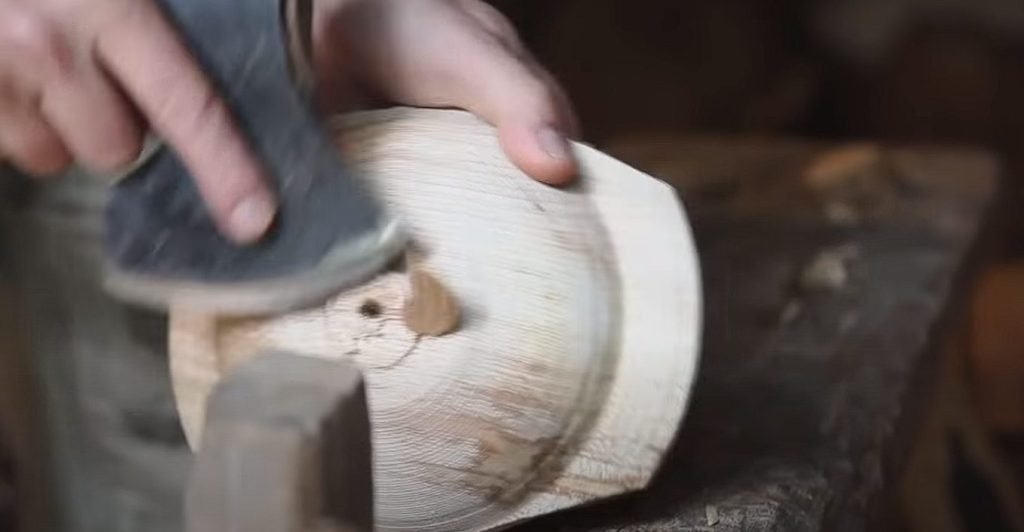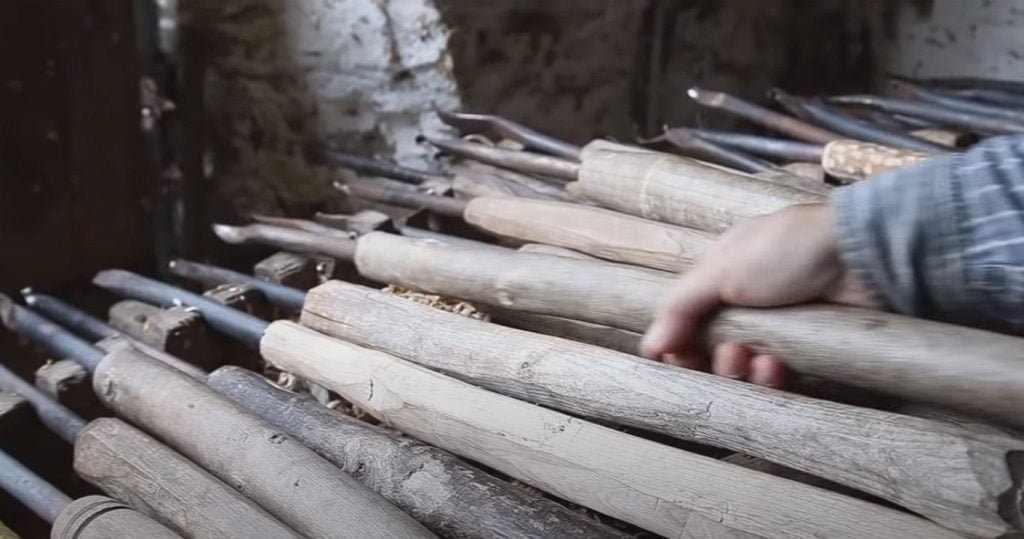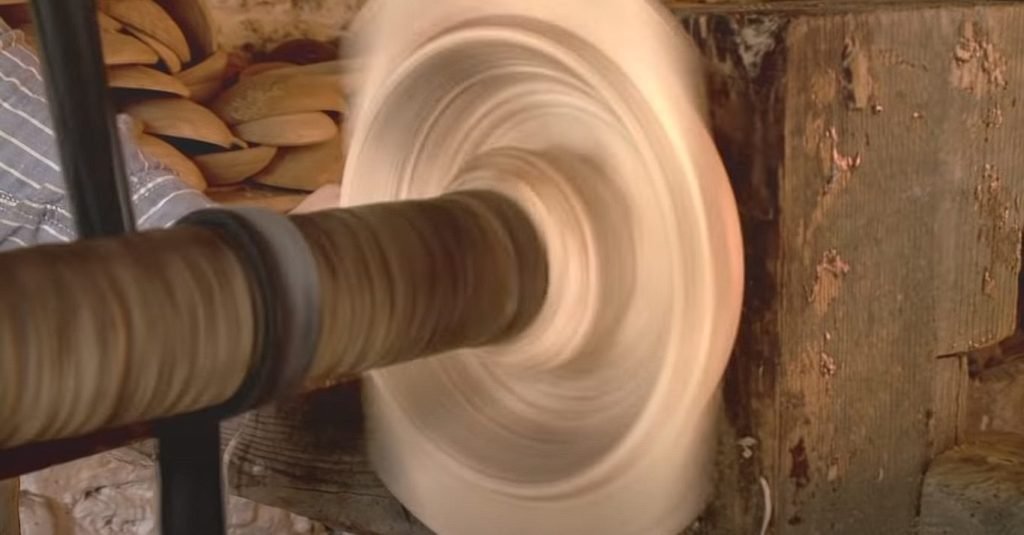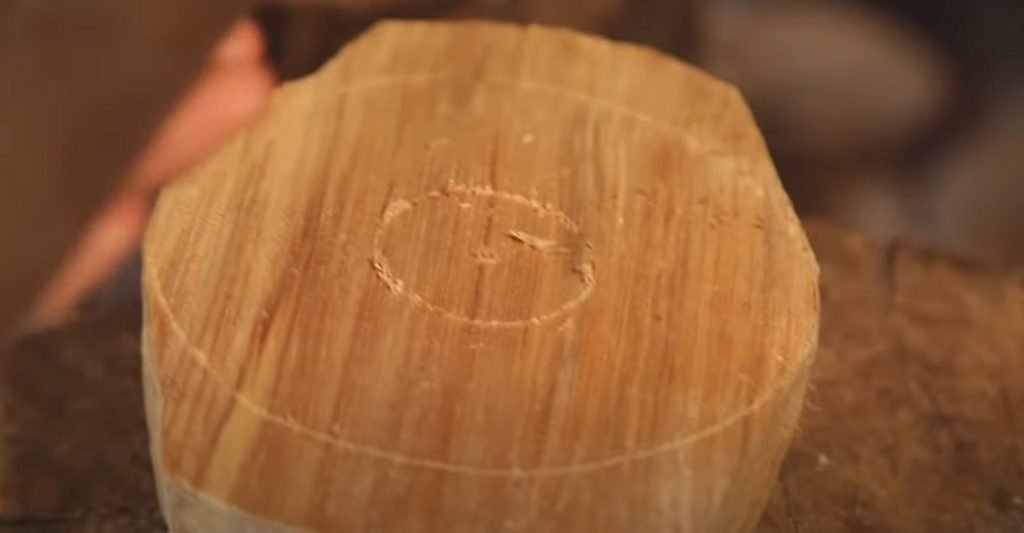Table of Contents
Woodturning is an ancient craft that uses a lathe to shape wood into functional and beautiful objects, such as wooden items. This skillful and creative process of woodturning has been used throughout history to make wooden items like bowls and toy wheels. It involves working with the wood’s grain and using traditional hand-turning techniques with a pole lathe. Let’s explore the history of woodturning work and how it has helped create timeless wooden items.

Tracing the Origins of Woodturning and the Lathe
Ancient Beginnings
Woodturning has ancient origins, with evidence of its practice dating back to ancient Egypt and Mesopotamia in the 1st century BC. Artisans in these civilizations utilized primitive lathes to hand-turn wood into various functional objects and decorative items. The development and use of woodturning during this period laid the foundation for the rich tradition that continues to thrive today. The artistry and skill demonstrated by these early woodturners’ hand-turning are a testament to their ingenuity and craftsmanship.
The invention of the lathe marked a significant milestone in the evolution of woodturning. This innovative hand-turning tool revolutionized how artisans approached shaping wood, enabling them to create more intricate designs with greater precision. Early lathes were operated manually by hand or foot, allowing artisans to manipulate the spinning piece of wood as they carefully carved it into desired shapes. This advancement enhanced efficiency and expanded the possibilities for creativity within woodworking.
Impact on Craftsmanship
The introduction of lathes transformed woodworking practices, empowering artisans with tools that facilitated smoother and more controlled movements when working with wood. As a result, artisans could produce turned wooden objects more efficiently while achieving higher levels of detail in their creations. This technological leap paved the way for new artistic expressions through woodworking, influencing various cultures across different regions.
Woodturning’s historical perspectives provide valuable insights into how human creativity has been intertwined with practical skills throughout history. Understanding the roots of woodturning enriches our appreciation for this time-honored craft while inspiring contemporary artisans to continue innovating within this traditional art form.
Evolution of Woodturning Techniques Through Ages
Diversification of Techniques
Woodturning techniques have evolved over the years, spanning different cultures and civilizations. Woodturning has seen remarkable diversification from simple spindle turning in ancient times to intricate ornamental turning during the Renaissance period. For instance, in ancient Egypt, around 1300 BC, wooden objects were created using a strap-driven lathe. This demonstrates how early civilizations developed unique methods for shaping wood.
The advancements in tools and technology have significantly influenced the development of new woodturning techniques throughout history. In ancient Rome, there was evidence of two-person lathes being used for larger woodworking projects. This innovation allowed for more complex and larger-scale wood-turned items to be crafted.
It is fascinating how diverse cultures across centuries have shaped woodturning into what it is today. Each civilization’s unique approach to woodworking has left an indelible mark on modern-day techniques.
Influence of Tools and Technology
The evolution of woodturning techniques can also be attributed to the continuous improvement in tools and technology across different historical periods. For example, during the Industrial Revolution, innovations such as metal lathes revolutionized woodturning by enabling greater precision and efficiency in shaping wooden objects.
This historical perspective on woodturning highlights its rich heritage and underscores its adaptability to changing technological landscapes over time.

Notable Contributions to the Art of Woodturning
Ancient Civilizations
Ancient civilizations, such as the Romans and Greeks, played a pivotal role in woodturning. They crafted functional items like wood turning using lathes. These early woodturners laid the foundation for the art form we know today. Their techniques and designs have influenced generations of artisans.
I used lathes and turning tools during this time, which allowed for intricate details and precise shapes in wooden objects. The legacy of these ancient woodturners can still be seen in modern pieces, showcasing a deep connection to history through craftsmanship.
Renaissance Resurgence
During the Renaissance, there was a resurgence in interest in woodturning as an art form. Skilled artisans began creating ornate-turned pieces that were functional and decorative works of art. This era shifted towards elaborate designs with embellishments like fluting, carving, and intricate patterns.
Renaissance woodturners elevated their craft by experimenting with different types of wood and incorporating new techniques into their work. As a result, they expanded the possibilities within woodturning, setting the stage for future innovation.
Modern Innovation
In contemporary times, modern woodturners continue to push boundaries within the craft by embracing both traditional methods and cutting-edge technologies. They explore new materials beyond wood while integrating innovative processes to create unique turned objects that blend history with modern aesthetics.
Today’s artisans draw inspiration from historical perspectives on woodturning while infusing their creations with personal touches that reflect current artistic trends.

The Lathe: A Revolutionary Tool in Woodturning History
Evolution of the Lathe
The invention of the lathe marked a pivotal moment in woodturning history. Before its advent, woodturning was a labor-intensive process, but this changed with the introduction of different types of lathes, such as pole lathes and treadle lathes. These innovations revolutionized woodturning during different historical periods.
The lathe allowed for greater precision and control in shaping wood. This resulted in more intricate designs, transforming the artistry involved in woodturning. For instance, pole lathes were used before the Industrial Revolution to craft items like chair legs and spindles by hand.
I find it fascinating how these advancements reshaped the efficiency and artistic possibilities within woodturning.
Impact on the Industrial Revolution
During the Industrial Revolution, technological advancements led to the development of high-output machines like great wheel lathes. These machines further increased productivity and expanded what could be achieved through woodturning.
This shift from traditional methods to more advanced machinery sped up production and opened doors for creativity and innovation within woodworking industries.
Learning about these historical perspectives has given me a deeper appreciation for the craftsmanship involved in creating turned wood pieces using both traditional and modern techniques.
Woodturning from a Historical Perspective
Cultural Significance
Studying historical perspectives on woodturning unveils its deep cultural significance. Throughout history, woodturning has been intertwined with various cultures, reflecting their values and beliefs. For example, ancient Egyptian wood-turned artifacts showcase the importance of craftsmanship in their society.
Understanding the historical context of woodturning provides insights into how different civilizations utilized this craft for practical and artistic purposes. By examining historical wooden objects from diverse regions, we gain a profound understanding of woodturning’s role in shaping societies.
Wood-turned items, such as ceremonial vessels or religious artifacts, often held symbolic meanings in traditional societies. This highlights woodturning’s spiritual and formal aspects, shedding light on its cultural importance beyond mere functionality.
Inspiration for Contemporary Woodworkers
Studying historical techniques can inspire modern-day woodturners to infuse traditional elements into their creations. For instance, learning about ancient turning methods might motivate contemporary artisans to incorporate similar design elements or tool usage.
By embracing historical perspectives, current practitioners can pay homage to the roots of woodturning while adding a unique touch to their pieces. It is fascinating how studying historical practices can spark creativity and innovation in my woodworking projects.
Exploring the evolution of woodturning honors tradition and fosters a sense of connection between past and present artisans. As someone passionate about woodworking, delving into the rich history behind this craft fuels my appreciation for its enduring legacy.

Significance of Woodturning in Cultural Heritage
Preservation of Traditions
Wood-turned objects hold significant cultural value, serving various societies’ utilitarian, ceremonial, and decorative purposes. The tradition of woodturning has been passed down through generations, contributing to the preservation of cultural heritage. For example, in some cultures, intricately carved wooden bowls are used for specific ceremonies or rituals, reflecting the deep-rooted traditions and beliefs.
The artistry involved in woodturning reflects the values and beliefs of different societies. This craftsmanship is a testament to the creativity and skill possessed by artisans from diverse cultural backgrounds. These woodturned objects give us insights into the aesthetic preferences and symbolic representations valued throughout history.
Symbolism and Values
Wood-turned items often carry symbolic meanings that are deeply rooted in culture. For instance, specific shapes or patterns on wood-turned pieces may symbolize prosperity or protection within a community. These symbols provide a window into the historical perspectives on how people perceived their surroundings and understood their place within society.
Personal insight: I find it fascinating how woodturned objects serve practical functions and embody rich cultural significance through their intricate designs and symbolism. It’s incredible to think about how each piece carries stories from generations past.
Historical Development of Woodturning as a Craftsmanship
Evolution from Functional Craft to Artistic Expression
Woodturning has transformed over the centuries, shifting from a functional craft to a recognized form of artistic expression. Woodturning initially focused on creating applicable items such as bowls, furniture legs, and utensils. However, as time progressed, artisans began to explore the artistic potential of woodturning, creating intricate and visually captivating pieces.
The transition from utilitarian objects to decorative art forms marked a significant turning point in the history of woodturning. This evolution expanded the creative possibilities for artisans and elevated woodturning into a respected art form embraced by enthusiasts and collectors worldwide.
Establishment of Guilds and Schools
Established guilds and schools dedicated to woodturning throughout history played a pivotal role in advancing its craftsmanship. These institutions provided aspiring artisans with learning and skill development opportunities while fostering an environment conducive to innovation and collaboration.
For example, during the 16th century in Europe, guilds were essential hubs for knowledge exchange among woodworkers. Sharing techniques and experiences within these communities contributed significantly to refining woodturning skills and promoting standardization across different regions.
Insights from Historical Records
Historical records and artifacts serve as invaluable resources that offer insights into the progression of woodturning techniques and styles throughout different periods. Researchers can trace the evolution of turning methods across various civilizations by studying ancient artifacts such as turned wooden vessels or tools used by early craftsmen.
Moreover, historical texts documenting woodworking practices provide detailed accounts that shed light on traditional methods employed by past generations. These resources preserve historical knowledge and inspire contemporary artisans seeking to incorporate traditional elements into their modern creations.

Preserving the Legacy of Woodturning for Future Generations
Documenting Traditional Techniques
Efforts to preserve historical perspectives on woodturning involve documenting traditional techniques passed down through generations. This documentation ensures that these valuable skills are maintained over time. By recording the methods used by artisans in the past, future generations can continue to learn from and build upon this wealth of knowledge.
Preserving the Legacy of Woodturning for Future Generations
Organizations and institutions dedicated to woodturning are crucial in promoting education and training in traditional techniques. They offer workshops, seminars, and apprenticeships to pass on these skills. For example, the American Association of Woodturners provides resources for both beginners and experienced turners, fostering a community where knowledge is shared.
Encouraging Young Artisans Encouraging young artisans to learn and practice woodturning is vital for ensuring the continuation of this rich heritage. By engaging with younger generations, seasoned artisans pass down their expertise while embracing new ideas and innovations. This interaction between experienced artisans and budding talents keeps the craft alive while allowing it to evolve with modern advancements such as steam power-assisted lathes.
Preserving historical perspectives on woodturning is essential for maintaining our cultural heritage. Learning about traditional techniques enriches our understanding of history and fosters creativity and craftsmanship among aspiring artisans.
At last…
In exploring the historical perspectives on woodturning, I’ve uncovered a rich tapestry of craftsmanship that has shaped cultures and traditions across centuries. From its humble origins to the revolutionary impact of the lathe, woodturning stands as a testament to human ingenuity and artistry. Understanding its historical development preserves a legacy and provides invaluable insights for contemporary artisans and enthusiasts, fostering a deeper appreciation for this time-honored craft.
As we conclude this journey through the annals of woodturning history, I urge you to seek opportunities to engage with this art form firsthand. Whether through workshops, museum visits, or personal experimentation, embracing the techniques and traditions of woodturning can offer a profound connection to our heritage and inspire innovations for future generations.
Frequently Asked Questions
What is the significance of woodturning in cultural heritage?
Woodturning holds significant cultural importance as it has been a part of various traditions and art forms across different cultures throughout history, showcasing the deep connection between craftsmanship and cultural identity.
How has the lathe revolutionized woodturning history?
The invention of the lathe revolutionized woodturning by enabling artisans to create more intricate and precise designs. This led to advancements in woodworking techniques and expanded the artistic possibilities within the craft.
Why is it essential to preserve the legacy of woodturning for future generations?
Preserving the legacy of woodturning ensures that traditional craftsmanship, historical techniques, and cultural significance are maintained over time. It allows future generations to appreciate and learn from this rich heritage while continuing its evolution.
What are some notable contributions to the art of woodturning throughout history?
Throughout history, notable contributions such as innovative turning methods, unique design styles, and influential artisans have significantly shaped the art of woodturning, lasting and impacting its development and evolution.
How can understanding woodturning from a historical perspective benefit modern artisans?
This provides modern artisans valuable insights into traditional techniques, design principles, and cultural influences. This knowledge can inspire innovation while preserving time-honored practices.
